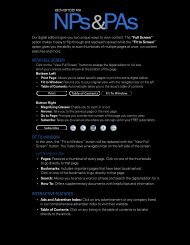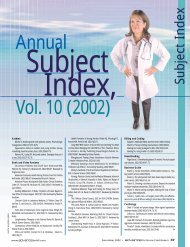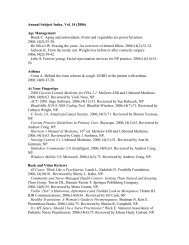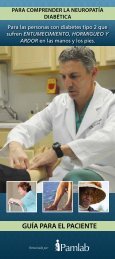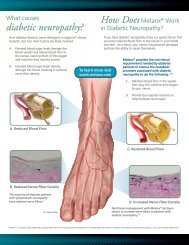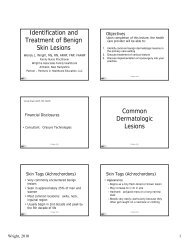View Full Screen - ADVANCE for NPs & PAs
View Full Screen - ADVANCE for NPs & PAs
View Full Screen - ADVANCE for NPs & PAs
Create successful ePaper yourself
Turn your PDF publications into a flip-book with our unique Google optimized e-Paper software.
Pediatrics<br />
The most obvious drawback <strong>for</strong> the preferred utilization of malathion is cost,<br />
since it requires both an office visit and a prescription.<br />
efficacious that permethrin 1%. 4-7 No<br />
reports of resistance have been associated<br />
with the current U.S. <strong>for</strong>mulation of<br />
this drug. 6 Malathion 0.5% lotion is safe<br />
to use on patients older than 6, and the<br />
gel <strong>for</strong>mulation is safe to use on patients<br />
older than 2.<br />
To deliver this treatment, the lotion or<br />
gel is applied to dry hair and allowed to<br />
air dry. The lotion remains on the hair<br />
<strong>for</strong> 8 to 12 hours; the gel preparation<br />
remains on the hair <strong>for</strong> 30 minutes. The<br />
gel is associated with fewer odors, easier<br />
application and less likelihood of eye<br />
irritation because of diminished dripping.<br />
Studies show that the gel <strong>for</strong>mulation is as<br />
effective as the lotion <strong>for</strong>mulation, with<br />
similar rates of retreatment. 2,5,7<br />
The most obvious drawback <strong>for</strong> the<br />
preferred utilization of malathion is<br />
cost, since it requires both an office<br />
visit and a prescription. Potential side<br />
effects must also be considered. Because<br />
malathion is a cholinesterase inhibitor,<br />
the potential <strong>for</strong> respiratory depression<br />
with ingestion is concerning. The<br />
potential risk of inadvertent ingestion<br />
by young children in the home should<br />
be considered. 2 No such cases have been<br />
reported, however.<br />
Newer Agents<br />
Three other pharmacologic agents have<br />
been introduced over the last 3 years to<br />
address emerging resistance. Benzyl alcohol<br />
5% (Ulesfia) lotion was approved in<br />
2009 <strong>for</strong> use as a prescribed pediculicide<br />
<strong>for</strong> the treatment of head lice in patients<br />
older than 6 months and in pregnant<br />
women. The lotion is touted as nontoxic<br />
because it does not contain pesticides;<br />
malathion 0.5% and permethrin 1%<br />
do. Ulesfia has a unique mechanism<br />
of asphyxiating lice by “stunning” their<br />
external breathing component. 8<br />
Ulesfia lotion should be applied in<br />
sufficient quantity to cover all lice on<br />
the hair and scalp. The application is<br />
rinsed off after 10 minutes and must<br />
be repeated in 7 days. In clinical trials,<br />
head inspection 1 day after the second<br />
dose showed clearance rates of 92% or<br />
higher. 5,8 Development of resistance is<br />
thought to be unlikely with Ulesfia since<br />
the mechanism of action opens the external<br />
breathing pathway of the louse.<br />
Spinosad 0.9% (Natroba) is a cream rinse<br />
<strong>for</strong> patients older than 4; it was approved in<br />
2011. This product is a prescribed pediculicide<br />
that targets the nicotinic receptor<br />
of acetylcholine and the gamma aminobutyric<br />
(GABA) gated chloride channel<br />
of the louse, causing paralysis.<br />
The hair and scalp should be saturated<br />
with Natroba and left on <strong>for</strong> 10<br />
minutes. In clinical trials, most patients<br />
only needed one treatment. A second<br />
treatment can be given in 7 days if live<br />
lice are still present. Eighty-five percent<br />
of patients were lice-free 14 days after the<br />
final treatment. While spinosad 0.9% is<br />
neurotoxic to lice, it is thought to have<br />
fewer side effects than permethrin. 5<br />
Ivermectin lotion 0.5% (Sklice) is a lice<br />
treatment <strong>for</strong> patients older than 6 months;<br />
it was approved in February 2012. This<br />
lotion is a prescribed pediculicide that also<br />
works on the GABA chloride channels,<br />
causing paralysis and resulting in death<br />
of the louse. The lotion is applied to dry<br />
hair and to the scalp. The contents of the<br />
entire 4-gram tube should be applied. The<br />
product should remain on the hair and<br />
scalp <strong>for</strong> 10 minutes be<strong>for</strong>e being rinsed<br />
out. The current recommendation is <strong>for</strong><br />
use as a one-time treatment.<br />
Two trials of ivermectin lotion demonstrated<br />
71% to 76% lice eradication<br />
14 days after a single treatment. 9 Oral<br />
ivermectin has been used off label <strong>for</strong><br />
the treatment of head lice <strong>for</strong> some time.<br />
Safety concerns exist about crossing<br />
Head Lice Through the Years<br />
➼ find our archived coverage of head lice by entering the term in our Search<br />
box at www.advanceweb.com/NPPA.<br />
the blood–brain barrier and potential<br />
<strong>for</strong> neural transmission interruption in<br />
younger patients. 2<br />
Rethinking Policy<br />
Head lice infestations in school systems<br />
across the United States are a public health<br />
nuisance and an economic burden on<br />
families. Prolonged absenteeism from both<br />
school and work are unnecessary considering<br />
the lifespan and patterns of the human<br />
head louse. Several health organizations<br />
recommend an end to “no nit” policies in<br />
American school systems. Children should<br />
be allowed to return to the classroom once<br />
treatment has been initiated.<br />
Permethrin is still considered the<br />
treatment of choice <strong>for</strong> head lice, but<br />
increasing pesticide resistance warrants<br />
consideration of other treatment modalities.<br />
Malathion, benzyl alcohol, spinosad<br />
and ivermectin should be considered <strong>for</strong><br />
head lice treatment since these therapies<br />
can be more efficacious than permethrin.<br />
While copayments and prescriptions are<br />
burdensome <strong>for</strong> some, these costs may<br />
be worth it when weighed against the<br />
potential <strong>for</strong> prolonged absence from<br />
school and work. 4 ■<br />
References<br />
1. Centers <strong>for</strong> Disease Control and Prevention.<br />
Parasites-Lice-Headlice. www.cdc.gov/parasites/lice/<br />
head/index.htm.<br />
2. Frankowski BL, Bocchini JA. Head Lice. Pediatrics.<br />
2010;126(2):392-403.<br />
3. Texas A&M University. Louse. http://insects.<br />
tamu.edu/fieldguide/aimg37.html.<br />
4. Gur I, Schneeweiss R. Head lice treatments<br />
and school policies in the US in an era of emerging<br />
resistance: a cost-effectiveness analysis. J<br />
Pharmacoeconomics. 2009;27(9):725-734.<br />
5. Keller E, Tomecki K. Cutaneous infections and<br />
infestations: new therapies. J Clin Aesthet Dermatol.<br />
2011;4(12):18-24.<br />
6. Meinking TL, et al. Comparative in vitro pediculicidal<br />
efficacy of treatments in a resistant head<br />
lice population in the United States. Arch Dermatol.<br />
2002;138:220-224.<br />
7. Meinking TL, et al. A randomized, investigatorblinded,<br />
time-ranging study of the comparative efficacy<br />
of 0.5% malathion gel versus Ovide Lotion (0.5%<br />
malathion) or Nix Crème Rinse (1% permethrin)<br />
used as labeled, <strong>for</strong> the treatment of head lice. Pediatr<br />
Dermatol. 2007;24(4):405-411.<br />
8. Meinking TL, et al. The clinical trials supporting<br />
benzyl alcohol lotion 5% (Ulesfia): a safe and effective<br />
topical treatment <strong>for</strong> head lice (pediculosis humanus<br />
capitis). Pediatr Dermatol. 2010;27(1);19-24.<br />
9. Sanofi. Sklice Lotion prescribing in<strong>for</strong>mation.<br />
http://products.sanofi.us/Sklice/Sklice.pdf<br />
14 <strong>ADVANCE</strong> <strong>for</strong> NP & <strong>PAs</strong>



